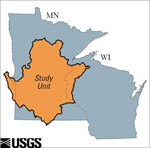Minnesota Water Science Center

UMIS NAWQAUSGS IN YOUR STATEUSGS Water Science Centers are located in each state. 
|
Volatile Organic Compound MonitoringDuring the summer of 1996 three storm-runoff events were sampled multiple times during increasing flow on Shingle Creek for volatile organic compounds (VOC's) when concentrations of these compounds were expected to be greatest. During 1997, two urban sites were sampled weekly to monthly for VOC's to characterize concentrations and loads during different seasons and hydrologic conditions:
Details in this study, soon to be published: VOLATILE ORGANIC COMPOUNDS IN TWO URBAN STREAMS IN THE TWIN CITIES METROPOLITAN AREA, MINNESOTA, JULY 1996 - NOVEMBER 1998, by James D. Fallon Abstract VOCs (volatile organic compounds) are a class of synthetic and natural organic compounds that are prevalent in an industrial society. Many are potentially harmful to environmental health. VOCs are emitted to land, water, and air as components of gasoline, asphalt, paints, solvents, plastics, dry-cleaning compounds, and pesticides; and are by- products of petroleum combustion, manufacturing emissions, and evaporation from drying applications. VOCs also are produced in natural processes, such as in soil-bacteria metabolization. Many aromatic hydrocarbons (such as benzene and naphthalene), alkyl benzenes (methylbenzene, ethylbenzene, 1,2-, 1,3-, and 1,4- dimethylbenzene), and some ethers and other oxygenated compounds (2-methoxy-2-methylpropane, or MTBE) are associated with gasoline, gasoline additives, asphalt, and general petroleum-based transportation activities. Halogenated alkanes often are used as aerosol propellants. Chlorinated alkenes often are used in dry cleaning (trichloroethene and tetrachloroethylene. Other compounds, including carbon disulfide and 2-propanone have anthropogenic uses and sources but also occur naturally in soils and wetlands. As a result of widespread human uses, VOCs are ubiquitous, especially in densely populated areas. Once emitted to the environment, the volatility of VOCs favors movement to the atmosphere. VOCs may enter surface water from atmospheric, ground water, point, and non-point sources at ambient temperatures and atmospheric pressures. Cold winter temperatures enhance absorption—the movement or partitioning—of VOCs from the atmosphere to surface water. The U.S. Geological Survey analyzed water from Shingle and Nine Mile Creeks in the Twin Cities metropolitan area (TCMA), Minnesota, for volatile organic compounds (VOCs) from August 1996 through November 1998, as part of the National Water-Quality Assessment Program (Figure 2). The VOCs investigated were selected because of their suspected effects on human and aquatic health, their special uses (such as additives in reformulated gasoline), their environmental effects (such as ozone depletion), or their tendency to bioconcentrate in animal tissues. This study indicates that more VOCs are present in TCMA streams and at greater concentrations than previously determined. Forty-two VOCs were detected, with detection frequencies as great as 72 percent. The most frequently detected VOCs were methylbenzene (toluene), 2-propanone (acetone), and tetrachloroethene, with detections in greater than one-half of samples. The VOC 2-methoxy-2-methylpropane (MTBE or methyl tert-butyl ether), a VOC of concern in parts of the United States because of its potential human health effects, use in reformulated gasoline, and high detection rates in ground- and surface-water, was detected in only one sample. The median number of VOCs detected per sample (11) was greatest during the spring. VOCs associated with petroleum-based transportation, including alkyl benzene and oxygenated compounds, were detected throughout the year. VOC concentrations were as great as 150 mg/L and the median concentration of total VOCs was 6.10 mg/L. No concentrations of individual VOCs exceeded U.S. Environmental Protection Agency drinking-water standards or health guidelines, although the median concentration of total VOCs exceeded several guidelines for the protection of human and environmental health for individual VOCs. Methylbenzene concentrations in two samples exceeded the Canadian aquatic-quality criterion (2.0 mg/L) for the protection of aquatic life, for which no U.S. guidelines exist. Differences in VOC concentrations between Shingle and Nine Mile Creeks were likely affected by physical and hydrologic characteristics and VOC loading rates. Stream gradient, stream velocity, and turbulence were greater in Nine Mile Creek than in Shingle Creek, which likely enhanced the volatilization of VOCs. Hydrologic differences also caused variable ice cover during winter that may have affected VOC concentrations and fates. Total VOC concentrations were substantially greater in the ice-covered Shingle Creek than the ice-free Nine Mile Creek. In the Shingle Creek Basin, 16 of 23 VOCs detected in ground water also were detected in Shingle Creek, suggesting that ground-water surface-water interactions are important. |